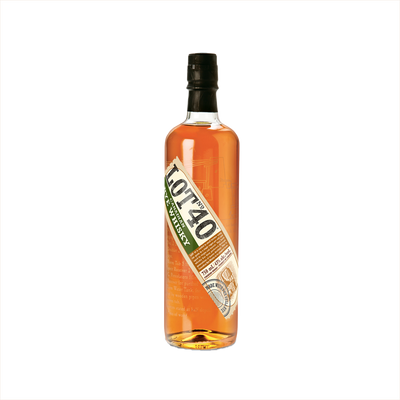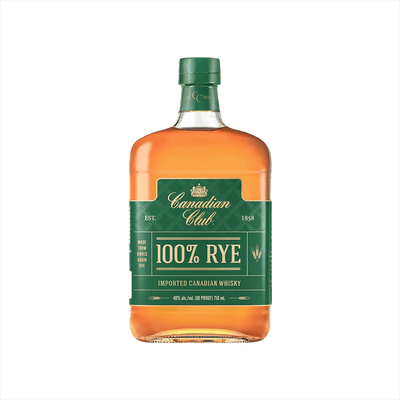Canadian Rye Whisky
What is Canadian Rye Whisky?
Canadian Rye Whisky is a distinctive style of Canadian Whisky that showcases the spicy, peppery character of rye grain as its defining ingredient. While Canadian whisky regulations are famously flexible, true Canadian rye whisky must contain a significant proportion of rye grain in its mash bill, giving it that characteristic bite and complexity that sets it apart from other Canadian whiskies. The category represents Canada's historical whisky-making traditions, where rye was often the grain of choice due to its hardiness in northern climates and its ability to create bold, flavorful spirits.
Learn More About Canadian Rye Whisky
What makes Canadian Rye Whisky unique?
Canadian Rye Whisky stands apart from other Canadian whiskies through its mandatory minimum 51% rye grain content, which creates a spicier, more assertive flavor profile compared to the smoother, often corn-heavy blends that define most Canadian whisky. While traditional Canadian whisky can contain any proportion of grains and relies on blending different grain whiskies for complexity, Canadian Rye must showcase rye as the dominant grain, resulting in pronounced peppery notes and a drier finish. This requirement makes it closer in spirit to American rye whiskey than to its own Canadian cousins, though Canadian distillation and aging methods still give it a distinctly northern character.
How is Canadian Rye Whisky made?
Canadian rye whisky starts with a mash bill that must contain at least 51% rye grain, which gets fermented with yeast and distilled in either column or pot stills to no higher than 94.8% alcohol by volume. The clear spirit then goes into charred oak barrels for a minimum of three years of aging, though most premium expressions age much longer to develop those signature spicy, peppery notes that rye is famous for. What makes Canadian rye particularly interesting is that distillers can age different grain whiskies separately and blend them together, giving them incredible flexibility to create complex flavor profiles.
How do you drink Canadian Rye Whisky?
Canadian rye whisky shines brightest when sipped neat or on the rocks, allowing its smooth, spicy character to take center stage without interference. It's also a fantastic base for classic cocktails like the Old Fashioned, Manhattan, and Whisky Sour, where its approachable nature and subtle spice notes complement traditional cocktail ingredients beautifully. While you can certainly enjoy Canadian rye year-round, it feels particularly at home during fall and winter months when its warming qualities match the season's cozy mood.
How do I choose good Canadian Rye Whisky?
Start by understanding that Canadian rye whisky often contains less actual rye than American rye, so taste a few different bottles to find your preferred spice level and smoothness. For sipping neat, look for higher-proof expressions with at least 40% rye content, while cocktails like Manhattans work beautifully with lighter, more approachable bottles that won't overpower other ingredients. Check the age statement and distillery notes – older Canadian ryes tend to develop rich vanilla and oak characteristics that shine in stirred cocktails, while younger expressions bring bright spice that cuts through citrus-forward drinks.
Nutritional Information
Typical Calorie Range per Ounce: 64-70 calories
Typical Carbohydrate Range per Ounce: 0-0.1 grams
Typical Sugar Range per Ounce: 0 grams
Typically Gluten Free: No
Canadian rye whisky contains grains that naturally include gluten proteins, making it unsuitable for those with celiac disease or gluten sensitivity. The distillation process may reduce gluten content, but cross-contamination during production remains a concern. Always check the specific product label and consult with the manufacturer if you have gluten-related dietary restrictions. Some distilleries offer certified gluten-free alternatives made from corn, rice, or other gluten-free grains.
Scrolled this far? Your reward? Canadian Rye Whisky Trivia!
- Canadian rye whisky doesn't actually need to contain any rye at all! Despite the name, Canadian regulations only require that the whisky possess the "aroma, taste and character generally attributed to Canadian whisky." Most Canadian distilleries use a base of corn with rye added for flavor, but some bottles labeled "Canadian Rye" contain zero rye grains. The name stuck from historical tradition when rye was more commonly used.
- During Prohibition, Canadian rye whisky was so smuggled into the U.S. that it literally changed American drinking habits forever. Bootleggers preferred Canadian whisky because it was lighter and easier to transport than heavy American bourbon barrels. When Prohibition ended, American palates had adapted to the smoother Canadian style, which is why many American whiskies today are lighter than their pre-1920 predecessors.
- The famous "Canadian Club" whisky got its name not from any exclusive membership, but as an insult turned marketing gold. In the 1880s, American bartenders dismissively called Hiram Walker's whisky "that Canadian Club whisky" to distinguish it from domestic spirits. Walker loved the ring of it and officially adopted "Canadian Club" as the brand name, turning American snobbery into one of the world's most recognizable whisky brands.
- Canadian distilleries can legally blend their whisky with up to 9.09% of other spirits - including rum, wine, or even brandy - and still call it Canadian whisky. This "9.09 rule" (derived from allowing up to 1/11th non-whisky content) means that bottle of Canadian rye might contain a splash of sherry, port wine, or Caribbean rum that gives it unique flavors you'd never expect from grain alone.
- The world's largest whisky aging warehouse sits in Gimli, Manitoba, and it's so massive it has its own weather system inside. Crown Royal's warehouse can hold over 1.5 million barrels across 46 floors, and the temperature variations between the bottom and top floors are so extreme that barrels age differently based on their location. Master blenders actually map out specific warehouse locations like vineyard plots to achieve desired flavor profiles.
Higher-proof spirits can be intense. Mix carefully, taste thoughtfully, and enjoy responsibly.
Gift message (optional)


